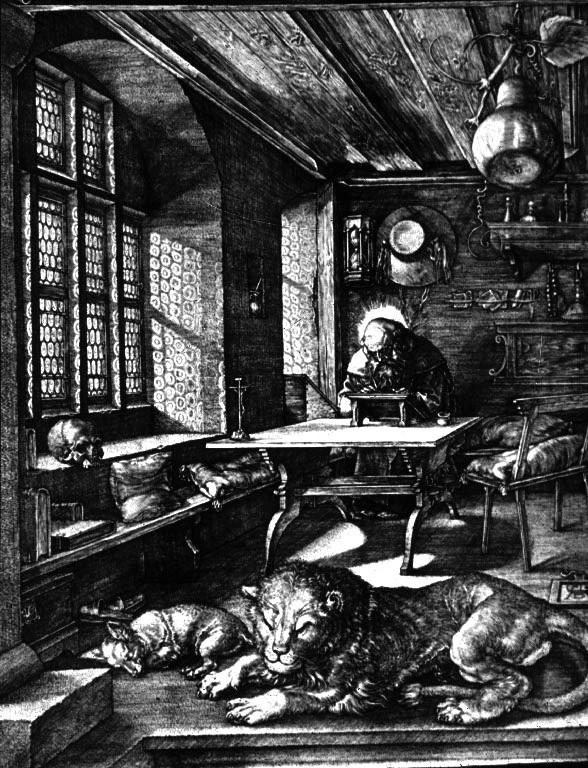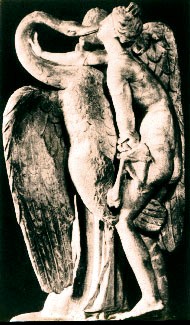The Artist
If the distinction between conceptual and perceptual can indeed be applied to individual works of art, it would seem to follow that we can sometimes describe artists themselves as tending by nature to one mode of “knowing” or the other.
Albrecht Durer, whose engraving, St. Jerome in His Study, (early 16th c.) appears in Fig. 2-20, is fairly typical of the conceptual school. Durer “enumerates” with consumate precision each element having particular “iconographic” meaning. From the era of the Van Eycks in 15th century Flanders, Northern artists commonly utilized complex graphic symbolism to encode specific religious and social meanings in their work.

Fig. 2-20. Albrecht Durer’s engraving, St. Jerome in His Study, reveals conceptual viewpoint with its plethora of minute reportage.
This required a highly developed literary motivation in both the artist and his audience, and produced, as in this case, richly conceptual visual documents. Durer notes carefully such details as the skull on the window-ledge and the hour-glass (both signifying mortality), the dog and sandals (denoting fealty), the lion (courage), the crucifix on Jerome’s desk and a grapevine hanging overhead (sacrifice), to mention but a few. Even reflections of round windowpanes are faithfully noted on the wall of the window seat.
Bringing this artistic tension between conceptual and perceptual approaches closer to our own time, let us now consider a modern work by the 20th century Spanish artist, Pablo Picasso, entitled Man Holding Lamb, 1944. (Figs. 2-21 & 2-21a) And for a contrasting viewpoint, let’s compare an Archaic Greek work known as the Calfbearer, 536 B.C. (Figs. 2-22, 2-22a) The “artistic problem” in both cases involves a relationship between man and beast.
Looking at a side-view of the Picasso work of 1944, it is fairly apparent that the man’s figure had to be fairly well developed before the lamb was “added.” The means by which the man is holding the lamb seems a tenuous one — and psychologically, we must deal with our feeling that the lamb may separate himself from his captor and fall.

Fig. 2-21 & 2-21a. Picasso “built-up” his Man Holding Lamb (1944) on a steel armature for eventual casting in bronze, so the “relationship” of man and animal depends on complex mechanical bonding of disparate elements.
The piece was clearly “built-up” with plaster or plastilene (a wax/clay mixture) over a metal armature, so parts could be added as it went along.The head of the lamb, like the man’s head, appears large and unstable on a long, tubular neck, consciously separating “head” from “body.” This approach appears highly conceptual in its disparate assemblage of arms and legs, and one wonders if perhaps there is latent content in that apparent awkwardness (i.e. WWI and WWII had seriously threatened the Humanistic idealism of our Renaissance/Classical past.)
In contrast, the Greek piece (which has been damaged) is carved from a single piece of stone, and there seems to be a natural unity that derives from the block of stone itself. (Everything must be planned before the process of carving is begun.) The Calfbearer almost literally wears the calf as a collar, while his arms are strategically “crisscrossed” with legs of the animal, bonding manand-beast geometrically. Moreover, in physical terms, the Greek man is not sharply differentiated from the beast — both have large, bovine eyes, smooth skin, and a serenity quite opposite from the “distress” of Picasso’s pair. In a closeup of the Greek piece, it is evident its unity derives from perceptual subordination of parts to a rhythmic geometry of the whole. While in the Picasso work, impasto texture over the surface of both animal and man also has a unifying effect, providing overall painterly quality. Both the Picasso and the Greek Calfbearer exemplify one trait which seems decidedly conceptual, the aspect of “frontality.” Neither artist apparently intended their work to be as significant viewed from the back as from a frontal location. (A throwback to ancient Mediterranean style of Egypt and later, Greece.)

Fig. 2-23 Picasso’s Goat (1951, bronze) emphasizes specific anatomical parts, “built” over metal armature with plaster or plastilene. Appendages such as head, tail, whiskers, horns may be “added” as an “afterthought.”
Looking further into the conceptual/perceptual predilections of this artist, one might also consider Picasso’s sculpture, Goat, 1950 (Fig. 2-23), noting that such “appendages” as head, horns, udder, or legs seem to have separate identity, which makes them virtually “detachable.” Comparison with a highly perceptual stone-carving entitled Bull, (Fig. 2-24) by American sculptress Pegot Waring, underscores the very “cerebral” or analytical character of Picasso’s approach. It may well be this attribute of the famous artist’s consciousness which had paved the way to Cubism, possibly the most analytical style evolved in painting or sculpture to that time.
Waring creates a stone-carving which depicts a charging bull, but an observer must intuitively project the flying hoofs and menacing horns, for the artist has eschewed all “unnecessary” description (features of this particular animal, such as dilated nostrils, hooves, etc.) in favor of a simple tactile mass hurtling through space.
In comparing stone-carvings to “built-up” works in clay or plaster, one might reasonably argue that an artist’s method partially determines conceptual or perceptual character of the finished work, for surely each artist chooses that technique which best manifests his/her intent.
At the risk of overstating importance of this fundamental contrast between conceptual artists (those focusing on analysis and differentiation) and perceptual artists (those bent on synthesis, sense and intuition), I would like to offer two further comparisons to illustrate the point.
Above are two treatments of the theme of horse-and-rider — one by an Italian sculptor, Marino Marini (Fig. 2-26, Horse and Rider, bronze, 1952) and the other, The Rattlesnake (Fig. 2-25, bronze, 1905) by the American, Frederick Remington.
As evidenced by the illustrations, Remington was a “for-real” cowpoke, who had ridden Western trails and knew the life of a “saddlebum” at first hand. He spares no detail of verisimilitude in depicting a horseman from the American West in a moment of peril. Musculature, saddlery, chaps and mane are all depicted in careful conformity to the facts. The only actor not visible in the drama is the snake itself.
Marini, in contrast, appears to be responding to the predicament of modern man after the ravages of WWII, and he “tells us” nothing superfluous about his Horse and Rider. We know little if anything about national identity, age of the rider, or circumstances of his distress. Neither horse nor rider is anatomically articulated into limbs with joints, or expressive facial components. Our senses and intuition convey an undercurrent of fright or loss of control, and particulars would hardly enhance that impact. Absence of differentiating textures of mane, chaps or leather critical to our experience of the Remington, in the Marini produces a unifying “metalic” patina which reinforces the single pyramidal mass of horse-and-rider.
Note that American sculptress Karen der Harootian similarly obscures distinctions (woman/bird, feathers/skin) in her perceptual stone-carving of Leda and the Swan, (Fig. 2-27) in favor of a unifying triangular form. Tactile geometry takes priority over story-telling here, to the extent that a casual viewer might not distinguish between two heads converging at the top of the simple marble form. The Roman sculptor, (Fig. 228) witholds no prosaic detail, opting instead for “full disclosure” of all available detail.

Fig. 2-22 & 2-22a. Archaic Greek Calfbearer (536 BC), of Acropolis Museum, links man and beast in wholistic matrix of a marble block (h. 3 ft 2 in.)

Pegot Waring's Bull (Fig. 2-24, n.d./stone) presents only a perceptual impression of threatening motion (above). Unity imparted by stone matrix provides contrast to complex analytical specifics of Picasso's more conceptual approach.

Fig. 2-25. The Rattlesnake by Remington (top/ 1905, bronze) offers a rich array of particulars (but no snake), while Marini's Horse and Rider (Fig. 2-26, 1952, bronze) focuses on a universal perceptual experience of angst.



